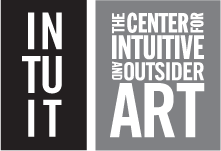Perhaps you are feeling a bit overwhelmed. You’re working at home with your partner or roommates, entertaining restless children, tackling organizational projects, or binge watching your favorite movies and shows. At this time of heightened anxieties, the thought of sitting down quietly with a book (and glass of wine) can seem both necessary…and impossible. Where to start?
Here are a few books to help pass the time, from Intuit Curator Alison Amick.

1. Outsider Art Sourcebook: International Guide to Art Brut and Outsider Art
Are you interested in learning more about outsider art but haven’t had the time? Don’t know where to start? This book is a great resource for learning more about the history of the field, associated artists, and different artist-built environments one can visit worldwide. Filled with timelines, artist biographies, excerpted writings, and colorful images, this sourcebook is a great place to begin. Use it to discover topics that might interest you.

2. Black Folk Art in America, 1930-1980, by Jane Livingston and John Beardsley with a contribution by Regenia Perry
This important exhibition traveled to the Field Museum in Chicago in 1983 and exposed many locals to the art of William Edmondson, James Hampton, Bill Traylor, Sister Gertrude Morgan, and Chicago artists William Dawson and Joseph Yoakum. Many of Intuit’s founders, inspired by this exhibition, discovered and activated a community of like-minded individuals, who eventually gathered together to launch Intuit in 1991. Given its importance to Intuit, the museum revisited this exhibition in 2016’s Post Black Folk Art in America, 1930-1980-2016. You can find Intuit’s catalog for this exhibition here.
Learn more
(or check out your favorite Indie book seller)

3. Chicago Calling: Art Against the Flow, by Kenneth Burkhart and Lisa Stone, with contributions by William Swislow and Dana Boutin
If you’ve ever wondered why outsider art is so important to Chicago, read this exhibition catalogue. This book explores the history of outsider art and its reception in Chicago through the lens of 10 important Chicago artists: Henry Darger, William Dawson, Lee Godie, Mr. Imagination, Aldo Piacenza, Pauline Simon, Drossos Skyllas, Dr. Charles Smith, Wesley Willis and Joseph Yoakum. It discusses the role places like Maxwell Street Market had on developing a local collecting aesthetic. The exhibition is now traveling internationally, having completed venues at Halle St. Pierre in Paris and Kunsthaus Kaufbeuren in Germany. If you are able to travel this summer, don’t miss Chicago Calling while it’s on view at Collection de l’Art Brut in Lausanne! The catalogue is available digitally or for purchase at Intuit.

4. Sublime Spaces & Visionary Worlds: Built Environments of Vernacular Artists by Leslie Umberger, with contributions by Erika Doss, Ruth DeYoung Kohler, Lisa Stone and Jane Bianco
Dreaming of traveling again? This book features in-depth writings about artist-built environments in the United States and the work the John Michael Kohler Arts Center has done to preserve them. Read up, and then get inspired to plan your trip to visit one post-COVID. See SPACES for some additional ideas!

5. African Voices in the African American Heritage by Betty M. Kuyk
I’m reading this book now. This book explores African influences in African American art through an in-depth exploration of the work of Sam Doyle and Bill Traylor. Join me!
“This is a book about the survival of African belief systems and social structures in contemporary African American culture. African slaves brought to North America were stripped of their possessions. Slave owners tried to strip them of their culture, too. The dominance of European American culture suppressed the traits of African traditions until the majority of scholars thought, even into the 1970s, that virtually all significant traces had been erased. But those scholars were wrong. Although the slaves’ hands were empty, their heads and hearts remained full. Africans kept their values in religious and family structures, and kept their ideas about how to organize their communities. Despite the traumas of slavery, Reconstruction, segregation, and continuing racism, these ways of life survived. Drawing on oral history, interviews, folklore, song lyrics, and the works of two major African American folk artists—Sam Doyle and Bill Traylor—as well as printed historical documentation, African Voices in the African American Heritage reveals African influences on African American life and shows how the African impulse fed American culture even into the 20th century.”
Learn more
(or check out your favorite Indie book seller)
Happy reading!

